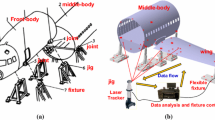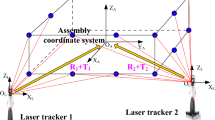Abstract
With the increasing requirements for aircraft assembly accuracy, pre-assembly analysis technology based on measured data has become one of the most important process precision compensation methods. How to accurately obtain and analyze the measured data of key features of parts according to assembly intention is the key step of pre-assembly analysis technology. Existing researches only explain the importance of the correct selection of measurement datum qualitatively, but none of them analyzed theoretically and provided specific methods when the measurement datum is inconsistent with the design datum, which is easy to misjudge the originally qualified parts. Therefore, this paper proposes a novel assembly-oriented measurement datum transformation and tolerance reallocation method for aircraft assembly. Firstly, based on the assembly type and geometric feature classification, the measurement datum of parts without Geometric Dimensioning and Tolerancing (GD&T) is identified, and the importance of correct selection of measurement datum is proved by a case theoretically. Secondly, when the measurement datum is not coincident with the assembly datum, a spatial homogeneous transformation method of measured data is proposed, which transforms the measured data from a temporary measurement coordinate system (TMCS) to an assembly datum coordinate system (ADCS). Finally, the tolerance redistribution of the measurement target features relative to the TMCS is carried out directly on the basis of the original tolerance. The experimental results show that the key features exceeding the upper tolerance limit of 0.042 mm are within the theoretical tolerance again after datum transformation, which solves the problem that the part has been misjudged as unqualified in the measurement process.


















Similar content being viewed by others
Abbreviations
- GD&T:
-
Geometric Dimensioning and Tolerancing
- TMCS:
-
Temporary measurement coordinate system
- ADCS:
-
Assembly datum coordinate system
- CMMs:
-
Coordinate measuring machines
- MCS:
-
Measurement coordinate system
- ADFs:
-
Assembly datum features
- MDFs:
-
Measurement datum features
- MTF:
-
Measurement target feature
- TMDFs:
-
Temporary measurement datum features
- N-TMCS:
-
Nominal temporary measurement coordinate system
- A-TMCS:
-
Actual temporary measurement coordinate system
- COD:
-
Coefficient of determination
References
Chen Z (2017) A digital metrology process model (MPM) for measuring planning and data analysis and its application with a computer-aided system. Int J Adv Manuf Technol 92:1967–1977. https://doi.org/10.1007/s00170-017-0294-1
Mei Z, Maropoulos PG. (2014) Review of the application of flexible, measurement-assisted assembly technology in aircraft manufacturing. Proc Inst Mech Eng Part B J Eng Manuf 228(10):1185–1197.https://doi.org/10.1177/0954405413517387
Luo ZW, Mei ZY (2013) Aircraft digital preassembly technology based on measured data. Aeronaut Manuf Technol 440(20):99–102+108. https://doi.org/10.16080/j.issn1671-833x.2013.20.048
Smith J (2011) Concept development of an automated shim cell for F-35 forward fuselage outer mold line control. USA: university of wisconsin-stout master dissertation. https://search.library.wisc.edu/catalog/9910806740702121
Peng Y, Hao, Huang X, Li Shuanggao (2022) A pre-assembly analysis technology of aircraft components based on measured data. Meas Sci Technol 33. https://doi.org/10.1088/1361-6501/ac60f7. https://doi.org/10.1063/5.0114714
Altinisik A, Bolova E (2021) A comparison of off-line laser scanning measurement capability with coordinate. Measurement 168(1). https://doi.org/10.1016/j.measurement.2020.108228
Muralikrishnan B, Phillips S, Sawyer D (2016) Laser trackers for large-scale dimensional metrology: a review. Precis Eng 44:13–28. https://doi.org/10.1016/j.precisioneng.2015.12.001
Kraus K (2007) Photogrammetry: geometry from images and laser scans. De Gruyter, Berlin, Boston. https://doi.org/10.1515/9783110892871
Maisano DA, Jamshidi J, Franceschini F, Maropoulos PG, Mastrogiacomo L, Mileham A, Owen G (2008) Indoor GPS: system functionality and initial performance evaluation. Int J Manuf Res 3(3):335–349
Peng Y, Huang X, Li SG (2023) A measurement point planning method based on lidar automatic measurement technology. Rev Sci Instrum 94(1):015104. https://doi.org/10.1063/5.0114714
Huang X, Gu P (1995) CAD-model based inspection of sculptured surfaces. International design engineering technical conferences and computers and information in engineering conference. Am Soc Mech Eng 17018:795–804. https://doi.org/10.1115/CIE1995-0807
Wang CJ, Zha BT (2023) Point cloud target registration algorithm based on local feature description. J Phys: Conf Ser 2478(6):062024. https://doi.org/10.1088/1742-6596/2478/6/062024
Li M, Wang Y, Sun Q, Mu X (2022) Assembly accuracy prediction and optimization of aero-engine rotor under the separation condition of assembly and measurement. Int J Adv Manuf Technol 120:3103–3112. https://doi.org/10.1007/s00170-022-08912-y
Wu Y, Gu Q (2016) General approach to establish datum reference frame based on constructing elements. Comput Integr Manuf Syst 241–247. https://doi.org/10.13196/j.cims.2016.01.023
Bhat V, Meter E (2000) An analysis of the effect of datum-establishment methods on the geometric errors of machined features. Int J Mach Tools Manuf 40(13):1951–1975. https://doi.org/10.1016/S0890-6955(00)00029-8
Chen S, Li T, Jiang Y (2022) Pose measurement and assembly of spacecraft components based on assembly features and a consistent coordinate system. Int J Adv Manuf Technol 120:2429–2442. https://doi.org/10.1007/s00170-022-08864-3
Xu XH, Shi YM (2003) Essentiality for consistency of measure benchmark and design benchmark in three coordinates measure. Mach Manuf Eng 10:76–77. https://doi.org/10.16731/j.cnki.1671-3133.2003.10.029
Zhao SL, Xiao Y (2005) Importance process of selection reference in geometric sense measuring. Automob Technol Mater 06:39–41
Zhang G, Zhang YH (2016) Brief discussion on how to correctly choose datum reference. Sci Mosaic 04:56–58
Mantripragada R, Whitney DE (1998) The datum flow Chain: a systematic approach to assembly design and modeling. Res Eng Design 10(3):150–165
Gao J, Gindy N, Chen X (2006) An automated GD&T inspection system based on non-contact 3D digitization. Int J Prod Res 44(1):117–134. https://doi.org/10.1080/09638280500219737
Stites WM, Drake PJ (1999) Geometric dimensioning and tolerancing. Dimensioning and tolerancing handbook. https://api.semanticscholar.org/CorpusID:107041944
Zhang HJ (2013) Research on industrial robots laser cutting application of trajectory planning and system calibration. Zhejiang Sci-Tech University. MA thesis. https://kns.cnki.net/KCMS/detail/detail.aspx?dbname=CMFD201302&filename=1013289252.nh
Pan GR, Zhou YY (2011) Comparison between two ways of calculation of coordinate transfer. J Geodesy Geodyn 31(03):58–62. https://doi.org/10.14075/j.jgg.2011.03.010
Sorkine O (2009) Least-squares rigid motion using svd. Tech Notes 120(3):52
Zio E (2013) The Monte Carlo simulation method for system reliability and risk analysis, 1st edn. Springer, London
Funding
This research was supported by the National Defense Basic Scientific Research Program of China (grant no. JCKY2020605C014) and the Postdoctoral Science Foundation of Jiangsu Province, China (grant no. 2022ZB217).
Author information
Authors and Affiliations
Contributions
All the related authors contribute to the conceptualization, data curation, methodology, writing original draft, writing review, and editing of the manuscript.
Corresponding author
Ethics declarations
Ethics approval
The article has been written by the stated authors who are all aware of its content and approve its submission.
Consent for publication
All listed authors approve to publish.
Conflict of interest
The authors declare no competing interests.
Additional information
Publisher's Note
Springer Nature remains neutral with regard to jurisdictional claims in published maps and institutional affiliations.
Rights and permissions
Springer Nature or its licensor (e.g. a society or other partner) holds exclusive rights to this article under a publishing agreement with the author(s) or other rightsholder(s); author self-archiving of the accepted manuscript version of this article is solely governed by the terms of such publishing agreement and applicable law.
About this article
Cite this article
Peng, Y., Du, K., Hou, G. et al. A novel assembly-oriented measurement datum transformation and tolerance reallocation method. Int J Adv Manuf Technol 131, 4281–4295 (2024). https://doi.org/10.1007/s00170-024-13152-3
Received:
Accepted:
Published:
Issue Date:
DOI: https://doi.org/10.1007/s00170-024-13152-3




